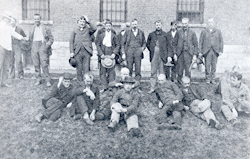
American
Studies Web Museum: Snapshots of common psychiatric practices and asylum life in Vermont at decade intervals from 1880 through today |
 |
Legal insanity was defined as "anything otherwise than normal," with disease in categories such as, "maniacal, melancholic, suicidal and homicidal tendencies." Efforts were made to prevent mental illness from becoming chronic, despite only 4 patients being released from the Brattleboro Retreat between 1878 and 1880. Treatment included work around the asylum, attending chapel, exercising at the gymnasium, and playing games at the amusement hall (like croquet, billiards and bowling).
|
||||||||||
|
Around this time, the decision to build an additional public hospital at Waterbury was made, allowing Brattleboro to place more focus on private patients. These changes sprang from trustees’ anger at having to discharge state patients, who produced revenue for the hospital, in order to care for transient and criminally insane. Monetary needs were thus a driving force behind the creation of a second hospital. For the most part, however, things at Brattleboro remained true to the hospital’s mission, with a heavy focus on activity to try to engage the mentally ill brain and take focus off of the insanity.
|
||||||||||
In 1900 the majority of the patients in mental hospitals were senile and at the end of their lives. At a point in time when the average lifespan for men and women was barely 50, 111 of the 281 patients at the State Hospital were over the age of 50. Also around 1900, Brattleboro began to take advantage of the establishment of a second hospital at Waterbury; all of their patients were either paying or state funded.
|
||||||||||
By the end of the first decade of the 20th century, the Brattleboro Retreat and the Vermont State Hospital for the Insane were well established. Insanity was taking a new course in history with a shift in perception of the places that cared for the insane from "asylum" to hospital. 1910 also marks the induction of new laws, one stating that criminals awaiting trial could be sent to the hospitals for observation, and the other filled with recommendations for the new commitment procedures. These laws inundated the hospitals with more patients than ever before.
|
||||||||||
Transparency became the modus operandi of the hospitals. New treatments such as hydro- and electrotherapy were proving successful, and with published success came the hope of accessing patients that would otherwise not have sought treatment. Although it was not expressly stated, it was inferred that as new treatments were created, and as they proved successful, the concept of mental health would also change. Possibly unbeknownst to doctors and nurses, through these new therapies, they began to address more severe disorders than ever before.
|
||||||||||
With a steadily growing patient population, expansion was key at Brattleboro. The development of employee housing was of particular importance because, despite the growing number of patients, the number of doctors and nurses was dwindling; the ability of the hospital to have employees on-site but also living comfortably was a major asset to the institution. Treatment also expanded: hydro- and electrotherapies were still used, but physiotherapy and occupational therapy were added. Despite an increase in treatment options, however, about 65% of patients discharged would later return, proving that while treatments were getting deeper into the heart of mental illness than ever before, there were still many advancements needed.
|
||||||||||
1950 marked the introduction of Miss Amanda Hardy, R.N and B.S to the staff at Brattleboro. Miss Hardy oversaw a new training course for the attendants, which required 30 classroom hours plus ward training, lectures and nursing demonstrations. On September 29, 1949, Brattleboro administered its first electroshock therapy treatment with astonishing results; 45 of the 113 patients treated with electroshock were discharged.
|
||||||||||
1960 was a turning point in the history of mental health in Vermont. Due both to “commitment procedures” that required patients to sign forms relinquishing their personal control to the hospital and to the “locked door stigma” of mental hospitals, many people who needed attention were not getting the help they needed. Brattleboro’s superintendant wrote, “mental illness is a sickness and should not be legally treated as a crime where danger to the public and to the person is not involved.” Antidepressants and tranquilizers were added to treatment plans, in addition to electro-convulsive therapy and group psychotherapy sessions.
|
||||||||||
In 1970 there was a push to get the hospital population back into their normal lives. The purpose of the hospital was no longer solely to provide a lifelong home for the mentally ill, but to help acclimatize them to life beyond the safe confines of the hospital. There existed dangers to the hospitals in these shifts, though, and Brattleboro was a prime example of how these changes in the paradigm could have potentially ended the run of hospitals for the mentally ill: staff doubled while patients halved, and the average stay shortened to 4 to 6 week from 4 to 6 months in 1960. Waterbury, however, demonstrated that the shift could create a new business model, with equally successful outcomes for the patients and the hospital itself. A Vermont law stated that financial issues would not bar anyone from receiving public aid; as a result, admissions at Waterbury rose 50%.
|
||||||||||
The 1980 biennium saw decreases in in-patient populations, admissions, discharges, deaths, and average lengths of stay. Within the hospital at this time, the most frequently occurring patient-reported problem was “disturbance with others” followed by “anger, belligerence, and negativity.”Over half of the referrals to the hospital in the years surrounding 1980 were from the Community Mental Health Services, and it is likely that the aforementioned decreases resulted from the local clinics’ success in serving and treating more and more people.
|
||||||||||
|
Brattleboro
Retreat
|
||||||||||